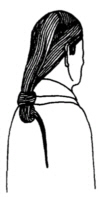Chapter 11 Section 4 Dressing
Women in the Han Dynasty regarded high buns as their beauty.As the nursery rhyme says, "The high bun in the city is one foot high. The eyebrows are wide in the city, with a square and half forehead." Although it is a bit exaggerated, it can still give a glimpse of the fashion of the Han Dynasty. "Princess Lu Yuan Biography" has a record of Empress Xiaohui Zhang's "Yunji E'e (a towering appearance), the head is not crowned and the bun is like a spiral spiral".There are many bun styles for women, some are piled on the head, some are divided to the sides, and some are left behind.The braiding and combing of the hair bun is generally divided into two by the top of the head, and then they are braided into a bundle, and then reversed from the bottom to the top to form various styles.Among them, the most famous ones are the vertebrae bun and the falling horse bun.The vertebral bun got its name because its shape is very similar to the wooden vertebrae used for laundry.According to legend, the falling horse bun was created by Sun Shou, the wife of Liang Ji, an aristocrat in the Eastern Han Dynasty.It hangs down to its back and sideways, as if it had just fallen from a horse, hence the name.Sun Shou wears this kind of hair in a bun, which matches with her thin and curved "frowning eyebrows" and "cry makeup" with a thin layer of oil on the eyelids, making her more charming and moving.In addition, women in the Han Dynasty also made their hair buns into various styles, and hung a lock of hair behind the bun, which was called "hanging hair [shao tip]" or "fen hair".Ladies often put steps on their heads for decoration.This is a kind of jewelry attached to the hairpin, decorated with golden jade flowers and animals, and colorful beads and jade hanging down.Because it shakes with the steps when walking, it is named.There are also those who wear pearl emerald flower hairpins on their heads and drum-shaped ear pendants on their earlobes.Han Yuefu's "Peacock Flying Southeast" describes the beauty of Jiao Zhongqing's wife Liu Lanzhi in this way: "The feet are crept [nie, stepping on] silk shoes, the head is bright with tortoiseshell [daimao], the waist is like flowing [wan pill], Listen to the bright moon pendant." The servants often wrapped their heads with scarves.Shi Dai, a thrush for women in the Han Dynasty, has become a fashion.Dai is applied on the eyebrows for beauty; powder is applied on the face for fairness; vermilion is applied on the cheeks for rosiness.Men at that time also "decorated their appearance with white powder and scratched their heads to show off their poses" ("Book of the Later Han·Li Du Lie Biography·Li Gu"), with femininity as their beauty.This trend spread to the Wei and Jin Dynasties, especially.Cao Cao's son-in-law, He Yan, used medicine to beautify his appearance in order to please women, and often "served women's clothes" ("Book of Jin·Wuxingzhi").

Falling horse buns of women in the Han Dynasty

Falling horse buns of women in the Han Dynasty
